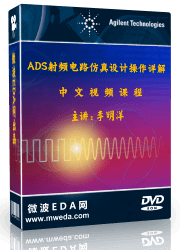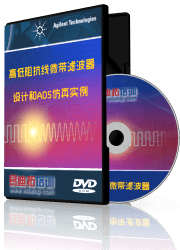- 易迪拓培训,专注于微波、射频、天线设计工程师的培养
ADS Momentum stacking multi layer and single-layer component simulations
录入:edatop.com 点击:
I'm simulating a 3-layer board (energy is coupled by a 'waveguide' from layer 1 to 3) followed by a coupled line bandpass filter.
I've simulated coupler and am satisfied with the results. I've also simulated a bandpass filter (albeit, on a single-layer board) and am satisfied with it. I stack them in ADS schematic (coupler and bandpass filter share a ground) and S-parameters add linearly. Next, when I copy and paste those two structures together, I get distorted signal, even though input and output impedances and matched to 50Ω relatively well.
I expected above two circuits give me identical response but it wasn't the case. I don't expect there to be crosstalk between the layers as they are well isolated, so who wouldn't response be identical? Does it have anything to do with how ports are set up in Momentum?
I have't considered checking it but but now that I have, turns out frequency response of my circuit is depended on substrate length and width.
I attached the a picture showing what happens when I only changed substrate dimensions.
What are the recommended dimensions of a substrate for EM simulation?
A little clarification on my post. What I meant by "substrate layer" was the ground plane layer. I do believe simulations are bounded by it as dielectric layers labeled with "infinite width" according to stackup definition.
I've simulated coupler and am satisfied with the results. I've also simulated a bandpass filter (albeit, on a single-layer board) and am satisfied with it. I stack them in ADS schematic (coupler and bandpass filter share a ground) and S-parameters add linearly. Next, when I copy and paste those two structures together, I get distorted signal, even though input and output impedances and matched to 50Ω relatively well.

I expected above two circuits give me identical response but it wasn't the case. I don't expect there to be crosstalk between the layers as they are well isolated, so who wouldn't response be identical? Does it have anything to do with how ports are set up in Momentum?

Hi,
Show the substrate definition for your single-layer and multi-layer boards.
One possibility is that since the surrounding environment of circuits is changed effective dielectric constant is also have been changed.
That's what I'm thinking, too. I used the same substrate definition for all structures.

If you have used the same substrate definition for all of your circuits, there shouldn't be the problem that I mentioned.

I have't considered checking it but but now that I have, turns out frequency response of my circuit is depended on substrate length and width.
I attached the a picture showing what happens when I only changed substrate dimensions.
What are the recommended dimensions of a substrate for EM simulation?
A little clarification on my post. What I meant by "substrate layer" was the ground plane layer. I do believe simulations are bounded by it as dielectric layers labeled with "infinite width" according to stackup definition.
申明:网友回复良莠不齐,仅供参考。如需专业帮助,请学习易迪拓培训专家讲授的ADS视频培训课程。
上一篇:Difference in results of HFSS and ADS
下一篇:Exchange format for Keysight Momentum on ADS
ADS婵炴垶鎼╅崢浠嬪几閸愵亝鍠嗛柛鈩冧緱閺嗐儵鏌涢埡鍐炬敯妞ゆ柨瀚板顐⑩枎閹存梹鐓� | More...
ADS培训课程推荐详情>>
 国内最全面、最专业的Agilent ADS培训课程,可以帮助您从零开始,全面系统学习ADS设计应用【More..】
国内最全面、最专业的Agilent ADS培训课程,可以帮助您从零开始,全面系统学习ADS设计应用【More..】
- Agilent ADS教学培训课程套装
- 两周学会ADS2011、ADS2013视频教程
- ADS2012、ADS2013射频电路设计详解
- ADS高低阻抗线微带滤波器设计培训教程
- ADS混频器仿真分析实例视频培训课程
- ADS Momentum电磁仿真设计视频课程
- ADS射频电路与通信系统设计高级培训
- ADS Layout和电磁仿真设计培训视频
- ADS Workspace and Simulators Training Course
- ADS Circuit Simulation Training Course
- ADS Layout and EM Simulation Training Course
- Agilent ADS 内部原版培训教材合集








